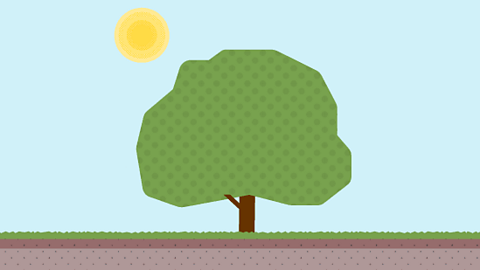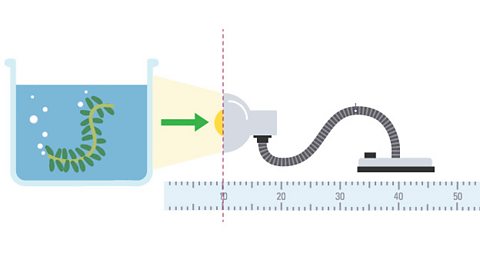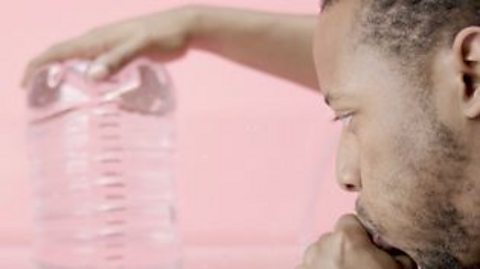Key points
photosynthesisA chemical reaction that occurs in the chloroplasts of plants in which the energy in light is stored in glucose. is a process that occurs in the leaves of a plant and needs both chlorophyllGreen pigment found within chloroplast that enables the process of photosynthesis to occur. and light energy.
During photosynthesis, the chlorophyll in leaves help convert carbon dioxide and water into the products oxygen and glucose.
The productMade in a chemical reaction when atoms separate from each other, rearrange and join together differently. glucose acts as a vital source of food for the plant.
Carbon dioxide, water and light are all needed for photosynthesis to take place.
Game - light intensity and photosynthesis
Play an Atomic Labs experiment to explore how light intensity affects levels of photosynthesis.
You can also play the full game
Photosynthesis activity
Play this game to see how a seed or a plant is affected by changing how much water, sunlight and carbon dioxide it gets.
What is photosynthesis?
Photosynthesis takes place inside plant cells in small objects called chloroplasts. Chloroplasts contain a green substance called chlorophyll. This absorbs the light energy needed to make photosynthesis happen. Plants and algae can only carry out photosynthesis in the light.
Plants get carbon dioxide from the air through their leaves, and water from the ground through their roots. Light energy comes from the Sun.
The oxygen produced is released into the air from the leaves. The glucose produced can be turned into other substances, such as starch and plant oils, which are used as an energy store. This energy can be released by respirationA chemical reaction that occurs in the mitochondria of cells in which glucose and oxygen react to produce carbon dioxide and water, releasing energy.
Video - Creating photosynthesis
The head groundsman at Derby County FC discusses how he uses knowledge of photosynthesis to maintain the pitch.
It's hugely important these pitches are absolutely pristine for the fans, the spectators, for the players, it's incredibly important. We have to have a safe surface so they're not getting injured, missing a shot, costing your team a chance for a win, the chance for a trophy.
I'm Nathan Scarff, and I'm the Head Groundsman in Derby County Football Club.
Working inside a stadium, we have a really big shade issue. The darkest area in this pitch will never see any sunlight. The plants struggle to photosynthesise naturally, so we use the lights to effectively synthetically induce the photosynthesis process and create the growth, so it gives the plant a lot of light energy and also some heat as well to encourage growth.
We are looking for just a healthy plant, something that's strong, something that's durable, something that would recover well.
The sciences that we use is predominately biology, we have a variety of measuring tools, we'll measure the moisture, the length of the grass, the hardness of the surface, everything is about producing absolute uniformity.
The first year that we had these lights, we won the award for best pitch in the championship. You do take a lot of pride away on what you do.
Can you answer these questions based on the video?
1. Derby County FC has a very big shade issue with regards to the growth of their grass pitch. What do they use to overcome this problem?
2. Name three qualities of the pitch that is measured to ensure healthy, durable grass to play football on?
Artificial lighting.
Moisture, length of the grass and hardness of the surface.
These are the things that plants need for photosynthesis:
- Carbon dioxide
- Water
- Light (a source of energy)
These are the things that plants make by photosynthesis:
- Glucose
- Oxygen
The word equation for photosynthesis in the presence of light and chlorophyll is:
Carbon dioxide + water → glucose + oxygen
Why is photosynthesis important?

Photosynthesis provides organisms with oxygen, a gas that many living things need. Oxygen is a product of photosynthesis and is needed for respiration. All organisms respire to release energy and to stay alive.
Without photosynthesis, life as we know it would come to an end, as almost every food chainA list of organisms in a habitat that shows feeding relationships and the energy which transfers from one to the next when consumed. depends on it either directly or indirectly. producerThe first organism in a food chain. Usually a green plant or alga which stores energy from sunlight as glucose during photosynthesis. such as algae, seaweed, grasses and phytoplankton all require photosynthesis to make their own food.
Photosynthesis brings about a balance in the ecosystem as it decreases the concentration of carbon dioxide in the atmosphere. Together with other processes such as respiration and combustionAnother name for burning. When a fuel reacts with oxygen and releases useful energy., it can help to maintain levels of oxygen and carbon dioxide in the atmosphere.
Without photosynthesis we wouldn’t have fossil fuels such as coal and petroleum, as these were formed from photosynthetic processes. These non-renewable sources were made by the breakdown of older plants.
Plant products such as timber, rubber and oil also require photosynthesis to be made.

Plants and animals working together
The composition of the atmosphere has changed since the Earth was formed 4.5 billion years ago. Natural processes, such as photosynthesis, have contributed to maintaining the levels of oxygen and carbon dioxide in the atmosphere, required for survival.
Plants release oxygen into the atmosphere as a by-product of photosynthesis and processes such as respiration and decompositionThe process of dead plants and animals breaking down into carbon dioxide, water etc. release carbon dioxide into the atmosphere. These processes work symbioticallyTwo things working together., where plants and animals depend on each other to benefit from this. Plants need the carbon dioxide released by respiration and decomposition, whereas animals need the oxygen released by plants from photosynthesis. This cycle helps maintain the balance of carbon dioxide and oxygen in the atmosphere.
Video - Golden jellyfish
Professor Brian Cox sees photosynthesis in action, investigating a unique type of jellyfish
Professor Brian Cox: All life depends on the flow of energy, which gets passed from one life-form to another. And there is one creature that embodies more than most just how that happens. This is the Golden Jellyfish.
A unique subspecies only found in this one lake, on this one island, in the tiny Micronesian republic of Palau. Golden Jellyfish have evolved to do something that very few other animals can do.' It really is incredible. As far as you can see, all the way down, till the light vanishes, there are jellyfish. And you can see they've congregated in the sun. If you go over there, to where the lake's in shade there are just none. And then in this pool of light beneath the sun, there are millions of them. Beautifully elegant things just floating around.
This lake is home to over 20 million jellyfish, whose success comes down to a remarkable adaptation. Their bodies play host to thousands of other organisms. Photosynthetic algae that harvest energy directly from sunlight. And once harvested, it's passed on to the jellyfish to use.
The energy flows from sun, to algae, to jellyfish.' The ones at the surface are gently turning and, the reason they do that is to give all their algae an equal dose of sunlight. 'And it's not just their anatomy that's adapted to harvest solar energy. Every morning, as the sun rises the jellyfish begin to swim towards the east.' And as the sun tracks across the sky, they move back again towards the west where they spend their night. So, the jellyfish have this beautiful, intimate, and complex relationship with the position of the sun in the sky. 'As sunlight is captured by their algae it's converted into chemical energy. Energy they use to combine simple molecules, water and carbon dioxide, to produce a far more complex one: glucose. Once absorbed by the jellyfish, glucose, and other molecules, not only power their daily voyage across the lake, they provide the basic building blocks the jellyfish use to grow the elegant and complex structures of their bodies.
So, the jellyfish, through their symbiotic algae, absorb the light, the energy, from the sun, and they use it to, well to live, to power their processes of life. And that's true, directly or indirectly, for every form of life on the surface of our planet. 'The sun's energy that bathes the Earth is harnessed by photosynthesis.
Once transformed, it's passed on from one lifeform to another as food. The flow of energy animates all living things.
The golden jellyfish has evolved to carry algae within their bodies and feed off the glucose the plants create.
The jellyfish move towards the light of the Sun throughout the day to increase photosynthesis. The symbiotic relationship between the two species allows the jellyfish to live off the glucose the algae produce.
Uses of glucose
Glucose is a useful molecule that is made during the process of photosynthesis. The initial use for glucose, when broken down during respiration, is to release energy.
Glucose is a molecule that can be bonded together to make many types of protein A food group used for growth and repair. Foods like meat, fish, eggs and dairy products contain lots of protein. including cellulose and starch (in plants) and glycogen (in animals). Think of it like each glucose molecule being an individual bead on a necklace and the entire necklace represents the carbohydrate molecule.
Plants only photosynthesise and synthesisThe production of chemical compounds by a reaction from simpler materials. glucose during the day when there is sunlight, but they use glucose for respiration all the time, including during the night.
Cellulose
Glucose is used to make cellulose. Cellulose is an example of a natural polymerA long and repeating chain of the same molecule stuck together.. Cellulose is the main component found in plant cell walls and this gives the plant cell strength and support.
Humans cannot digest cellulose, but it is important in your diet as fibre. Fibre assists your digestive system, keeping food moving through the gut and pushing waste out of the body.
Starch
Other uses of glucose produced from photosynthesis is to make the insoluble storage molecule starch. Most plants including rice, potatoes and wheat store their energy as starch. Starch is also a polymer and can be converted back to glucose by the plant when it is needed, for example at night for respiration.
Fats and oils
Glucose can also be converted to fats and oils such as olive oil. Fats and oils are also used by the plant as a storage form of energy.
Amino acids
Glucose produced in photosynthesis can be used to help make amino acids. These amino acids are used by the plant to synthesise protein A food group used for growth and repair. Foods like meat, fish, eggs and dairy products contain lots of protein.. Minerals such as nitrate ions are also absorbed by the roots of the plants to help make these amino acids. Foods such as peas are good protein sources.
Test your knowledge
Teaching resources
Looking for more resources to help your class master tricky scientific concepts? In this short clip, Dr Chris van Tulleken explains the process of Photosynthesis and how it produces energy in food.
91Čȱ¬ Teach has thousands of free, curriculum-linked resources to help deliver lessons - all arranged by subject and age group.
Play the Atomic Labs game! gamePlay the Atomic Labs game!
Try out practical experiments in this KS3 science game.

More on Respiration and gas exchange
Find out more by working through a topic
- count10 of 13

- count12 of 13

- count13 of 13

